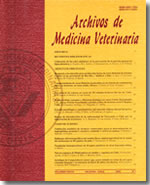In vitro and field diagnosis of anthelmintic resistance in gastrointestinal nematodes of small ruminants
Main Article Content
Abstract
The problem of anthelmintic resistance in ovine trichostrongyles is growing in tropical areas such as Chiapas, Mexico. Hair-sheep breeds are frequently used by farmers because of their climate adaptation, however, anthelmintic resistance incidence requires more sensitive methods of diagnosis in this region in order to apply selective treatments. The aim of this study was to evaluate in vitro and in vivo the relative efficacy of the three main anthelmintics used to control gastrointestinal nematodes (GIN) in hair sheep. Naturally infected ewes and lambs experimentally infected with 100 larvae (L3) of Haemonchus contortus and Cooperia curticei per kg body weight were used. Sheep were treated with 10 mg kg-1 albendazole, 7,5 mg kg-1 levamisole or 0,2 mg kg-1ivermectin. Positive faecal samples were cultured to obtain infective larvae (L3). Larvae of C. curticei and H. contortus were tested in vitro and data were analyzed using the PROBIT procedure. Also, the relative anthelmintic efficacy was evaluated by faecal egg reduction test (FECRT). The results of the FECRT showed 30% of levamisole efficacy while efficacies of and 87%, 64% and 65% were observed for ivermectin, albendazole and commercial combination of ivermectin + levamisole (Iv+L), respectively. Problems of anthelmintic resistance were manly showed with the mix Iv+L. The lethal dose (LD50) to albendazole, levamisole and ivermectin estimated after 12 h were 38, 8, 9,5 and 0,41 mg. These result show anthelmintic resistance problems in hair sheep using the three main commercial drugs and for the combination of Iv+L in the tropical region of Chiapas, Mexico.

